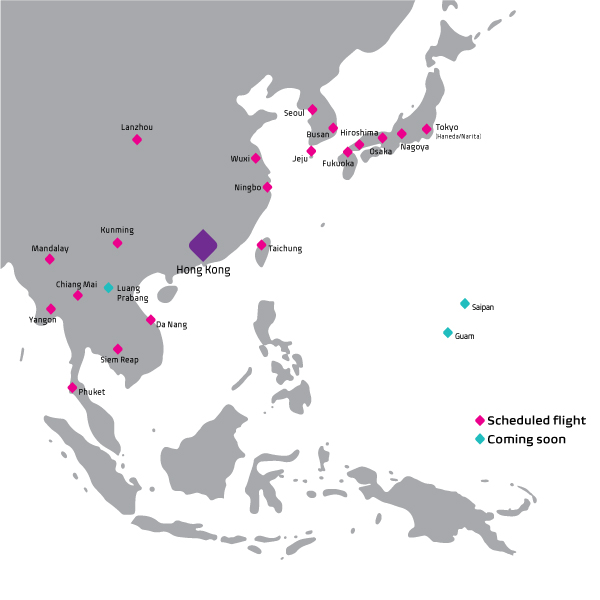HK Express begins year 3 as LCC; a greater threat to Cathay than Jetstar Hong Kong would have been
Jetstar Hong Kong flies after all: although Hong Kong rejected the application of the proposed LCC in Jun-2015, much of Jetstar Hong Kong's strategy and rationale has been realised by HK Express, which is now in its third year as a LCC. HK Express is arguably having a larger impact on travel and market stimulation - and competition to Cathay Pacific - than Jetstar Hong Kong would have. HK Express launched earlier, securing a sizeable slot pool, and its positive market reception is pressuring sister full service carrier Hong Kong Airlines to be more visible and competitive.
HK Express' successful transformation and growth is also giving confidence to its HNA Group owners to deepen its experimentation with LCCs; Chongqing-based West Air has taken up the LCC platform and others will follow - including on long haul flights. A strengthening HNA Group, across full service and low cost spectrums, will pressure Cathay in ways Jetstar Hong Kong would not have been able.
HK Express does nearly two thirds of its flying to Japan, once a lucrative market for Cathay. These were easy sells compared to HK Express' next task of building demand, in the very classical LCC way, of new markets for Hong Kong, including points in Myanmar, Laos and the Pacific Islands, which the LCC expects to open in 2016.
HK Express believes that it was right that markets over-ordered next generation narrowbodies; HK Express will receive early A320neo and A321ceo aircraft.
HK Express' impacts extend beyond its home market
HK Express had been nearly indistinguishable from sister carrier Hong Kong Airlines until the HNA Group, owner of both carriers, set out to transform HK Express into an LCC. HK Express re-launched as a LCC in Oct-2013. Even if Jetstar Hong Kong had been approved, it would not have been able to fly until at least mid-2016, giving HK Express a three year head start.
HNA had mooted turning HK Express into an LCC prior to Jetstar Hong Kong's Mar-2012 announcement. HK Express was not exercising foresight; Jetstar had approached parties including HK Express to run the LCC. It was the Jetstar Group's interest that played a major role in HNA's thinking to make HK Express an LCC.
To turn the carrier into an LCC, HNA brought in Mango Aviation, whose Andrew Cowen is now CEO of the airline. The transformation has seen a brand re-launch (visually and changing the name from Hong Kong Express to HK Express), construction of its own route network and support functions, and migration from Travel Sky to Navitaire. These have brought two sets of impacts.
First are the typical direct consequences, such as a growing LCC presence in Hong Kong and forcing foreign competitor LCCs to be more aggressive (benefitting the Hong Kong market).
Second are the indirect impacts, and these are unique. HK Express has shown the HNA Group that having a higher degree of autonomy from headquarters can bring success. HK Express has brought LCC experience to the HNA Group, which is now studying LCC plans in short and long haul markets. As a result, HNA could develop the world's first alliance of LCCs. HK Express' visible brand and presence in the Hong Kong market is forcing a previously sleepy Hong Kong Airlines to refresh its image and gain stronger recognition. HK Express' eventual migration to Navitaire demonstrates to the group the need for stronger IT platforms. As with branding, Hong Kong Airlines (on Travel Sky, for now) looks secondary to the more efficient HK Express.
Direct strength from HK Express and indirect spill over is benefitting the HNA Group, which has far wider interests across China (and thus a concern to Cathay/Dragonair) than Jetstar Hong Kong would have. Jetstar's partial Qantas ownership would have been a symbolic annoyance, but HK Express is a strategic threat - even if a fraction of Cathay's size. Attacking core markets, albeit with only a portion of Cathay's capacity, puts downward pressure on yields and sets market expectations for other destinations. Cathay as a result has to be more reliant on other markets, but those too present growing competition.
Perhaps in hindsight Cathay would have preferred the confined Jetstar Hong Kong impact to an influential HK Express.
Had Cathay not fought so hard against Jetstar Hong Kong, Jetstar Hong Kong could have precluded HK Express' re-launch and follow-on developments. Protectionism often produces unwelcome and surprising offspring. In its fight against LCCs, Cathay may have won a battle but but set the fuse for a wider war. The spoils go to HK Express.
See related report: Jetstar Hong Kong licence application rejected: Hong Kong becomes an island of protectionism in Asia
HK Express to take A320neo and A321ceo aircraft
At CAPA's Nov-2015 Asia Aviation Summit, Mr Cowen detailed the big strides the carrier has made in its fleet plan. HK Express operates 13 A320ceos with an average age of 4.6 years, according to CAPA's Fleet Database. In early 2015, HK Express expected to operate 15-20 aircraft in 2016, including 5-10 A321ceos. HK Express planned to return some of its A320s that were part of the launch fleet from Hong Kong Airlines and have different engines.
See related report: HK Express to grow to 15-20 aircraft in 2016, pursuing LCC hybridity with A321s and interlines
Mr Cowen said HK Express will take 12 A320neos and 10 A321ceos. The A320neos arrive in Aug-2016 and HK Express will take four in 2016, 2017 and 2018. "We've been able to take advantage of the emerging over-ordering of neos, which we thought would happen," Mr Cowen told CAPA TV. The A321ceos will be delivered from 2016 to 2018. These will seat 230 in an all economy configuration, 28% more than HK Express' typical 180 seat A320s.
The A321 strategy, as CAPA previously noted, is driven by a few components: slots shortages in Hong Kong and elsewhere (Phuket) and traffic right restrictions (Tokyo Haneda) mean growth needs to occur through up-gauging rather than frequency growth. In some markets without such restrictions but perhaps limited demand, up-gauging could be more a conservative strategy than adding an additional frequency.
HK Express CEO Andrew Cowen discusses the airline's growth: Nov-2015
HK Express is the fourth largest airline in Hong Kong, now surpassing China Airlines
HK Express in Dec-2015 is the fourth largest carrier at Hong Kong airport based on available seat capacity. HK Express has surpassed long-standing China Airlines of Taiwan, although by only a small amount. However, further growth will see HK Express become considerably larger than China Airlines. HK Express in Dec-2015 is about half the size of Hong Kong's third largest carrier, Hong Kong Airlines. Although HK Express is undertaking significant growth, it is unlikely HK Express will surpass Hong Kong Airlines (also growing) in seat capacity.
However, a radical change (although not planned) between Hong Kong Airlines and HK Express by introducing an integrated dual brand strategy could mean HK Express takes on more short haul point to point flying while Hong Kong Airlines focuses on long haul growth, namely to Australia and North America. While HK Express is fourth largest at Hong Kong based on seats, this reflects its short haul flying; based at ASKs, HK Express is eighth largest.
Hong Kong International Airport seat capacity by carrier: 30-Nov-2015 to 6-Dec-2015
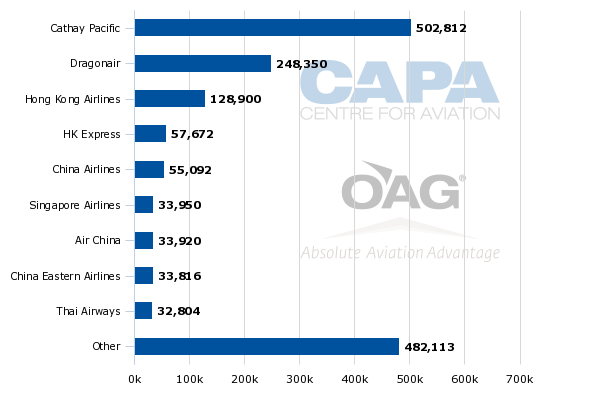
LCCs account for 10% of Hong Kong capacity. HK Express has one third of LCC market
LCCs in Dec-2015 account for 10% of Hong Kong's available seat capacity, according to OAG. For the full 2015 year, the figure is 9%. 2016 should be the first year Hong Kong has an average LCC penetration rate in the double digits.
The LCC penetration rate is still low but has picked up pace since 2013 when HK Express converted to the LCC model (and there were developments from foreign LCCs).
LCC capacity share (%) of total seats: 2003 to 2015
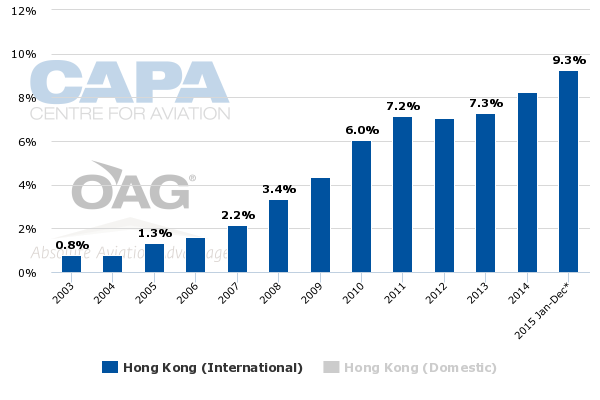
HK Express, Hong Kong's only LCC, accounts for 34% of LCC seat capacity at Hong Kong. In comparison, at Singapore, LCCs account for 30% of the market (they have grown while Singapore Airlines has shrunk, but other full service carriers - such as from the Gulf - are rapidly expanding). Singapore-based LCCs account for 61% of Singapore's LCC market, clearly demonstrating the benefit of multiple locally domiciled LCCs.
Hong Kong LCC seat capacity share by carrier: 30-Nov-2015 to 6-Dec-2015
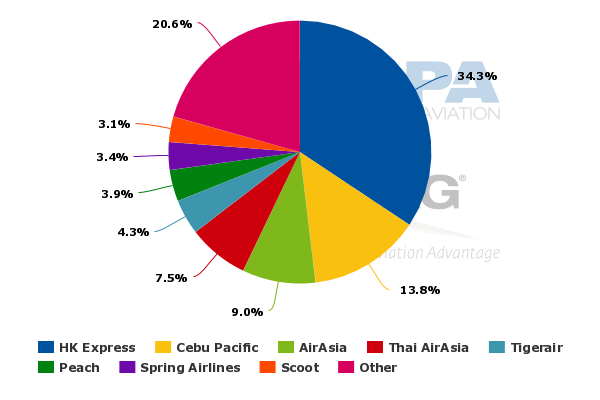
The Jetstar Hong Kong rejection has meant other parties considering a Hong Kong LCC base have abandoned that thought, leaving HK Express as Hong Kong's sole local LCC for the foreseeable future.
This is to HK Express' advantage: while it accounts for 34% of Hong Kong's still nascent LCC market, the largest LCC in relatively mature Singapore, Tigerair, holds 27%. (The expected Tigerair-Scoot merger would see the two have a larger combined share of Singapore's LCC market, although this would comprise both long haul and short haul capacity.)
Singapore LCC seat capacity share by carrier: 30-Nov-2015 to 6-Dec-2015
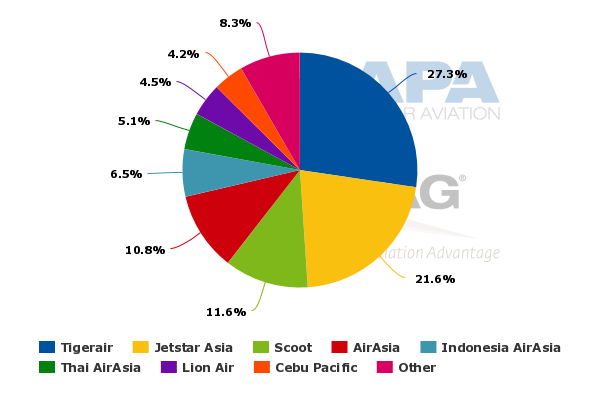
HK Express has focused on Japan but now looks to all new markets: Myanmar, Laos and Pacific islands
HK Express has focused on Japan, where it serves five cities and six airports (HK Express serves Tokyo from both Haneda and Narita). This is HK Express' largest spread of destinations but also capacity: Japan accounts for 48% of HK Express' seat capacity and 61% of ASKs, according to OAG data.
HK Express seat capacity by market: 30-Nov-2015 to 6-Dec-2015
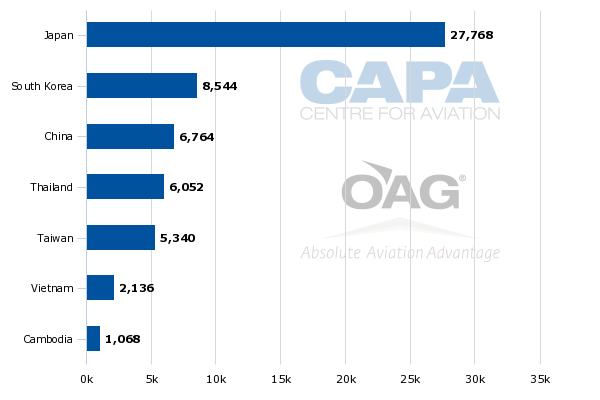
Mr Cowen remarked of HK Express' Japan focus: "that reflects the demands of the Hong Kong travelling public… previously the routes to Japan were flag carrier duopolies with very high fares". HK Express had fortuitous timing, re-launching as a LCC just as Japan's yen weakened, causing significant inbound demand.
Whereas previously Japan was a strong outbound market where even leisure passengers were willing to pay high full service fares, the inbound market is price sensitive and very willing to travel on LCCs.
HK Express route map: Dec-2015
Until 2013, the outbound Hong Kong market comprised about a quarter of the total Japan-Hong Kong market (excluding third country nationalities). This has now flipped: in 10M2015, the outbound Hong Kong component comprises 60% of the market.
The overall market is growing too: In the first 10 months of 2015 (latest data available), the total Hong Kong-Japan market is already 4% larger than all 12 months of 2014, meaning Nov-2015 and Dec-2015 visitor arrivals into Japan will be pure growth. Japan expects to exceed 20 million foreign visitors in 2015, five years ahead of schedule.
Tourism between Japan and Hong Kong: 2009-10M2015
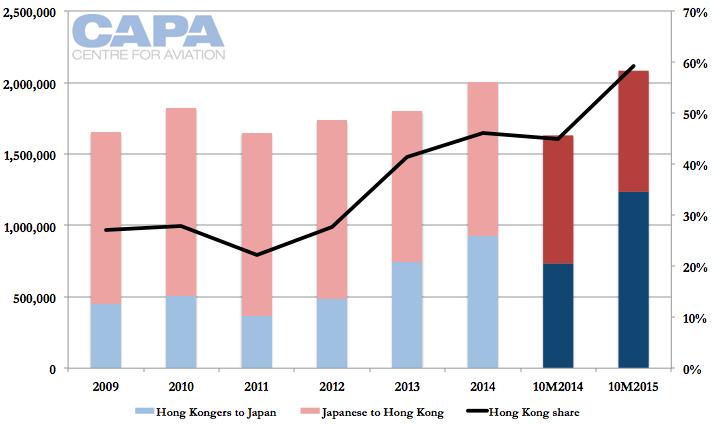
HK Express has also grown in Korea while mainland China sees another spread of cities from HK Express (but with lower frequency). Given the bent towards Japan, Northeast Asia predominates HK Express' network: its only other market is Southeast Asia. Southeast Asia accounts for 16% of available seats and 13% of ASKs. HK Express is now turning to growth in other markets, partially as a result of saturating its key Northeast Asian opportunities (in terms of demand, slots and traffic rights). Growth elsewhere will help HK Express diversify away from Japan, although there are few risks (the yen is unlikely to appreciate).
Exact dates and frequency of service are still being finalised, but HK Express expects in 2016 to open service to Luang Prabang in Laos, the first time in recent history there will be regularly scheduled flights between Hong Kong and Laos.
HK Express intends to open two points in Myanmar: Yangon and Mandalay. Dragonair and more recently Myanmar National Airlines serve the Yangon-Hong Kong route, but Mandalay is unserved.
Hong Kong to Myanmar (seats per week, one way): 7-Jan-2013 to 15-May-2016
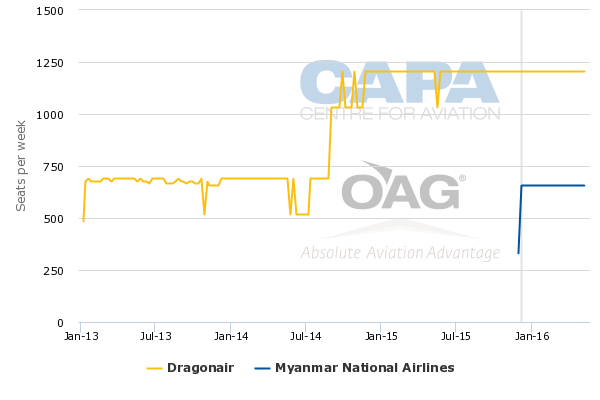
HK Express intends to open two markets in the Pacific: Guam and Saipan. Guam has been served with scheduled service by United Airlines (and merger partner Continental) four times weekly with a 737 and fares are generally high. The last scheduled service between Hong Kong and Saipan was in 2005 by Continental, according to OAG data.
Guam tourism statistics state there were approximately 165 weekly visitors to Guam from Hong Kong in 2014, a 3.7% decline from 2013. 2014 visitor figures were up only 1% compared to 2011, showing the lack of stimulation in the market. Mainland China, however, grew 40.1% between 2013 and 2014 (280 weekly visitors) and mainland Chinese visitors have more than doubled between 2011 and 2014.
As indicated by the weak Hong Kong tourism figures, there is little market awareness or thought from Hong Kong of visiting Guam and Saipan, let alone the far larger destination of Hawaii (which also lacks non-stop service to Hong Kong). HK Express will need to build awareness not just of its flights but what the markets offer.
In contrast, its core outbound markets of Japan, Korea and Thailand were well known but lacked affordable travel options.
HK Express' proposed service to Saipan comes with an additional challenge: after Saipan and Guam were announced via a short statement, Hong Kong Airlines applied to US authorities to serve Hong Kong-Saipan four times weekly with an A330 from 2Q2016. This regulatory process is involved, indicating Hong Kong Airlines' Saipan intent is not a passing thought. The overlapping announcements reflect how network planning is not integrated between HK Express and Hong Kong Airlines, and how this will likely be a further problem as the two continue to grow.
Dual brand coordination is needed with Hong Kong Airlines - and across HNA
The transformation of HK Express to a LCC and its growth has helped give the HNA Group's Hong Kong operation a meaningful presence in Hong Kong's top markets. HK Express and Hong Kong Airlines serve eight of Hong Kong's top 10 markets based on seat capacity. The exceptions are Singapore and Manila.
As for Singapore, Hong Kong Airlines assistant director commercial Michael Burke said at the CAPA Asia Aviation Summit in Nov-2015 that serving Singapore would be "wildly competitive" for an airline like Hong Kong Airlines. (Hong Kong Airlines briefly flew with A330s while waiting for route approval elsewhere. The large capacity but low frequency was not successful.)
Mr Burke noted: "80% [of seats on Singapore-Hong Kong] are Singapore Airlines and Cathay Pacific, two of the strongest brands and stickiest loyalty programmes and strong cargo revenues…That's really bloody difficult to compete against." He queries: "How can you logically propose that when it's clear the route was going to be loss making from the get go. There's only so much strategic intent you can put in that before you run out of cash."
While Singapore may not work for Hong Kong Airlines as a point to point market, or with regional Asian connections, Mr Burke noted Hong Kong Airlines would need a presence - likely virtual - in Singapore for its forthcoming North American expansion: "The art is then how are you relevant enough to things like corporate travel programmes to sell your network when you don't have a vital route like Singapore-Hong Kong… So that's where partnerships come in."
Hong Kong International Airport top 10 routes ranked on available seat capacity: 30-Nov-2015 to 6-Dec-2015
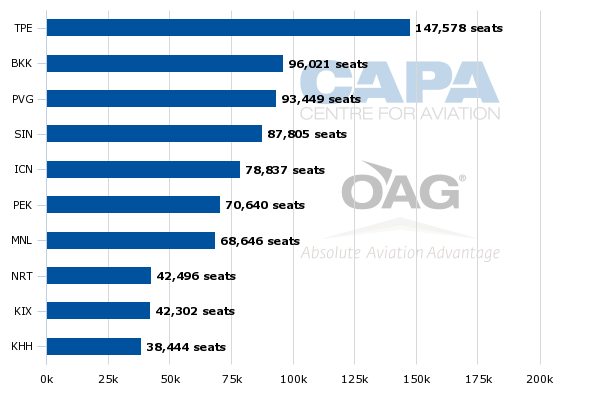
Although there may be discussions between HK Express and Hong Kong Airlines for fleet and back office functions, the Saipan incident - both carriers saying they will serve the market, unaware the other was thinking the same - demonstrates the isolation HK Express and Hong Kong Airlines have in network strategy. They will increasingly overlap in strategic thought.
As CAPA has previously noted, the existing network between HK Express and Hong Kong Airlines has quirks. Japan is mostly served by HK Express, but Hong Kong Airlines flies to Sapporo (where HK Express' A320s do not have sufficient range) and smaller points with A320s, perhaps better suited to HK Express. Hong Kong Airlines serves Bangkok while HK Express serves Phuket. Key HK Express markets in slot-constrained or bilateral-constrained airports could perhaps be better served with a widebody aircraft (especially in a high density configuration).
The opaque ownership structure of HK Express and Hong Kong Airlines could mean a dual brand strategy requires different shareholders to give and take, which is not an easy ask. Coordination would be easier if HK Express and Hong Kong Airlines were under one ownership structure. There is the typical fear (far from groundless) of the young, agile LCC being reined by the older but less efficient full service sister. Whatever HK Express and Hong Kong Airlines see as the competition between them, the larger concern is competition from everyone else.
It is a similar story across the HNA Group and, as the airline portfolio expands, is a growing concern. There is increasing overlap in mainland China as HNA expands with more airline licences and existing carriers extend their network. Hainan Airlines announced its intent to serve Tianjin-Vancouver, but then sister carrier Tianjin Airlines said it also wanted to serve Tianjin-Vancouver.
Although the HNA carriers are part of one group, they have individual ambitions and strength to achieve their own outcome. HK Express-Hong Kong Airlines coordination could be a predecessor to more complicated integration with mainland based HNA carriers.
Hong Kong third runway financing biased against HK Express
Hong Kong, like Japan, is a market that was said not to be capable of supporting LCCs. But like its peers in Japan, HK Express is making its operation work. Unlike in Japan, the welcome mat is not being rolled out. HK Express has faced a number of challenges, including in the critical areas of slots: their availability and the transparency of their allocation. This persists: HK Express reckons it could open another 20 destinations if slots were available.
A new challenge, and one that will also impact its business for the long term, is Hong Kong's revised proposal to finance the third runway. Passenger charges will increase for departures regardless of length of haul, delivering a higher proportional tax on short haul travellers (as HK Express' passengers are) than long haul (as at Cathay Pacific).
Transfer passengers will be insulated from this. Although HK Express offers a "GoConnect" transfer product, transfers are a very small part of their business. In comparison, at Cathay transfer passengers are about half of the carrier's total. HK Express takes the blunt view that under the new scheme it will be subsidising Cathay's operation. However, there appears to be little opportunity to fight since the revised proposals are what most expect will be implemented.
HK Express core transfer markets: Dec-2015
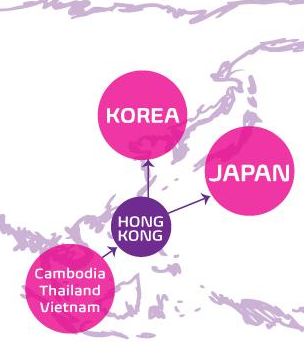
HK Express completes its brand transformation and expects full year profitability
HK Express in Oct-2015 introduced a new uniform, completing its brand transformation. Ongoing CASK reductions and full year profitability demonstrate the LCC approach can work in Hong Kong, despite all that's been thrown at the carrier (and foreign operators).
HK Express' success is more notable as HK Express had the challenge of going through the difficult process of changing existing systems and practices rather than starting afresh. Aside from not having to secure a licence and AOC, a clean sheet design is usually much easier to manage and achieve low costs with.
No one is expecting a radical change of mindset that would see Hong Kong proactively work with LCCs. HK Express can continue to expect challenges, new and old, thrown at it. Slots remain the key issue, and its agility and multiple network options will see it grow even if its first, second or third (or more) ideal growth options are not possible.
Asian aviation growth is increasingly defined not by what it is strategic rational but what slots permit.
